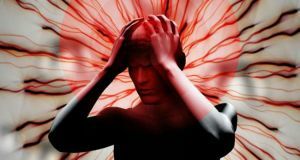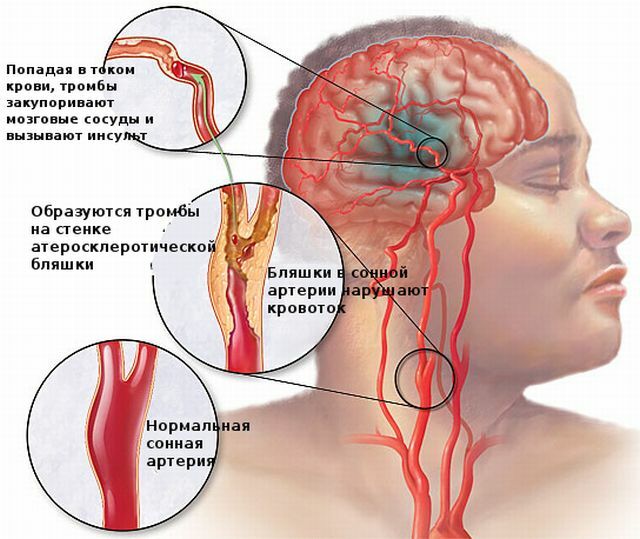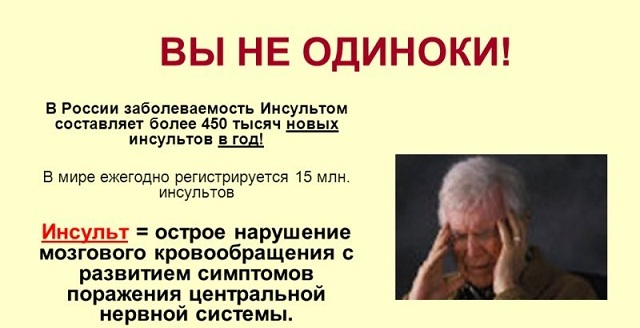Stem stroke - a stroke, which affected brain region, called the barrel. Such localization is characterized by a negative prognosis and high probability of survival of disability.

Causes
Bleeding in the brain stem may have ischemic nature and caused by occlusion of vessels with atherosclerotic plaques. According to statistics, this is the nature of the disease in 90% of cases. Besides plaque causes of ischemic stroke may include:
- thrombophlebitis, thromboembolism;
- inflammation of the blood vessel wall;
- ciliary arrhythmia character;
- disorders of the cervical spine;
- arteritis.
This condition is also called cerebral infarction.
The remaining 10% of the stroke is hemorrhagic in nature and is caused by rupture of the vessel. Most commonly affects the trunk bridge.
Causes hemorrhagic lesions may be:
- traumatic brain injury;
- diabetes;
- vascular malformations;
- softening of the vessel wall, or a congenital anomaly;
- hypertension;
- aneurysm of the arteries.

symptoms
When the brain-stem stroke symptoms are reduced to severe violations, such as:
- pain in the neck;
- dizziness;
- impaired balance and speech;
- skewed person;
- paralysis of individual body parts;
- Disorder of sensitivity in the affected area;
- constriction of the pupils;
- depression of consciousness;
- fever and high blood pressure;
- violation of the respiratory rhythm and frequency of myocardial contractions.
Cerebrovascular accident hemorrhagic develops more rapidly than ischemic.
Treatment
The main condition for the prevention of disability due to the effects of hemorrhagic or ischemic stroke in the brain stem, is the beginning of treatment in the first hours after circulatory disorders. The treatment regimen reduces to:
- removal of brain tissue edema;
- restoration of normal blood supply to the areas affected by stroke;
- eliminate hypertension attack;
- Measures to combat the formation of blood clots.

drug therapy
Ischemic stroke brain, as well as spinal and brain stem, requires a comprehensive approach to treatment. Patient following groups of drugs are assigned:
- diuretics;
- substances that prevent the formation of clots;
- anticoagulants;
- neuroprotective agents;
- antibiotics, tetracycline group is preferred.
If there was a hemorrhagic stroke, Therapy is supplemented with hemostatic drugs. In addition, if there are indications of antihypertensives are added or, alternatively, an antihypertensive medication. In addition to these means use inflammatory and analgesic drugs.
Surgical intervention
If medication is ineffective impact, to remove the hematoma, hemostasis in hemorrhagic stroke and restore vascular patency in ischemic disease type operation is performed on the head brain. There are several types of interventions:
- thrombolytic administration through the hole drilled in the skull;
- open craniotomy.

The reconstruction of the vessel can be carried out during the operation, the hardening of the damaged areas, the installation of Special scaffolds aneurysm removal and other actions aimed at restoring the blood supply system brain.
whether recovery is possible
For a man who had undergone stem stroke recovery outlook negative. According to statistics, the probability of a full recovery is not more than 3%, provided that the medical care in the first hours after the onset of circulatory disorders. In the first 3 days of dying up to 80% of the total number of patients who had bleeding in the brain stem, the prognosis of survival at 5 years is 20%.
There is a high likelihood of developing these complications:
- violation of swallowing function;
- the emergence of speech defects;
- disorder of motor function;
- decreased coordination;
- failure of thermoregulation of the organism;
- loss of control over the movement of the eyeball;
- disturbance to the functioning of the respiratory center.

Ischemic brain stem stroke, due to the fact that develops less rapidly, giving more time to render first aid to the patient and increase the chances of survival and recovery. The answer to the question of stroke brainstem whether recovery is possible, will not only localize the seat, but also the start of therapeutic measures.
Maximum recovery of the disturbed functions can only be provided timely rehabilitation. Early recovery period plays a key role. If after a stroke months passed, return mobility paralyzed limbs and eliminate other violations will not succeed.
To restore the patient's physician prescribes physiotherapy exercises and complex consisting of respiratory components, as well as active and passive limb movements. In addition, substantial aid could have a massage. For the normalization of the speech can be used speech therapy exercises with elements of music therapy.



